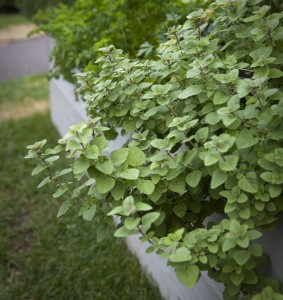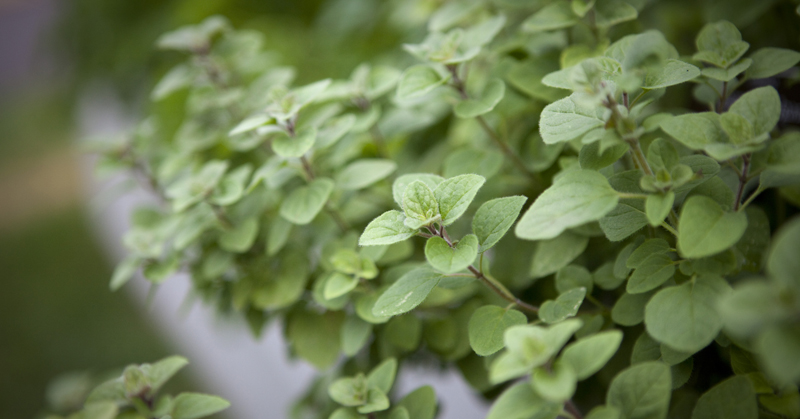“O” is for Oregano
Posted in Gardening Tips on June 3 2014, by Sonia Uyterhoeven
Sonia Uyterhoeven is the NYBG’s Gardener for Public Education.
 The name oregano is derived from the Greek oros (meaning mountain) and ganos (meaning joy). The literal translation means “mountain of happiness,” since it covers hillsides in the Mediterranean and smothers them with beautiful fragrance and flowers. For our purposes, that translation still applies, as oregano is a fundamental herb that provides as much flavorful happiness as it does beauty or aroma.
The name oregano is derived from the Greek oros (meaning mountain) and ganos (meaning joy). The literal translation means “mountain of happiness,” since it covers hillsides in the Mediterranean and smothers them with beautiful fragrance and flowers. For our purposes, that translation still applies, as oregano is a fundamental herb that provides as much flavorful happiness as it does beauty or aroma.
Greek and Roman brides and grooms used to be crowned with laurels made of oregano. It is a popular herb in Mediterranean countries and widely grown in the south of France, where it finds a prominent place in various regional cuisines.
On a more practical level, oregano is an herb that retains its flavor well when dried. For a quick primer on drying herbs, it is important to harvest your herbs mid-morning, once the dew has a chance to dry off, but before they are wilted by the hot afternoon sun. Inspect the herbs and remove any damaged or diseased foliage.
The old fashioned way to dry herbs is to tie them into bundles and hang them in the closet. I use rubber bands that I wrap around several times, so the rubber bands adjust as the herbs dry and the stems shrink. Otherwise use cotton cooking twine and tie it very tightly. Take a paper clip and open it up into a makeshift hook that attaches to the rubber band on one end and a coat hanger on the other.
Place in a warm, dry spot away from direct light. It takes a week or two to dry, depending on the herb you are using. Sometimes a paper bag can be placed around the bundle to provide protection and collect any seed or debris that might drop. Herbs retain flavor and color better when dried indoors as opposed to outdoors.
You can also place your oregano on a screen or a drying rack. Place a dishtowel or cheese cloth underneath, then turn the herbs every day and wait until dry. Small herbs such as oregano should dry in less than a week. If you are in a hurry, you can even turn your oven on the lowest setting and leave the door open. The herbs need good air circulation to dry and the lowest oven temperatures can often be on the high side for many herbs. Check frequently and give them a few hours to dry. But you should also remember that leaving your oven open can expose you to carbon monoxide, so this method should only be employed with open windows and plenty of good ventilation.

Once dry, store your oregano in an airtight jar away from direct light and heat. The herbs will retain their maximum flavor for 6 months to a year. When using dried herbs in a recipe that calls for fresh ones, make sure you use half the amount. If the herbs are finely ground, you may want to cut the amount back by ¼. When you are drying herbs they should still look green, but they will crumble in your fingers when ready. If they are brown, you have gone too far and they are best used in potpourri.
My favorite use for fresh oregano in the summer is to simply add it to a salad for flavor. It also makes for an essential pizza ingredient and does beautifully with roast vegetables. It adds nice flavor to meats as well—particularly lamb and beef.
Greek oregano (Origanum vulgare hirtum) is the most common supermarket oregano, with a pungent flavor. Italian oregano (Origanum × majoricum) is a hybrid between oregano and sweet marjoram. It combines the best of both parents, being both pungent and sweet. One of my favorite oreganos is a variety called ‘Hot and Spicy’ (Origanum vulgare ‘Hot and Spicy’). It has a nice kick to it and tastes as if it was dusted with hot peppers. For a milder option and brighter color in your garden, you can grow golden oregano (Origanum vulgare ‘Aureum’). Whichever one you choose—used fresh or dry—you can’t go wrong.

